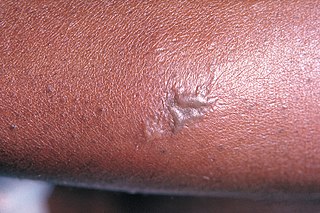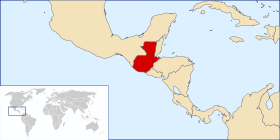
Syphilis is a sexually transmitted infection caused by the bacterium Treponema pallidum subspecies pallidum. The signs and symptoms of syphilis vary depending in which of the four stages it presents. The primary stage classically presents with a single chancre though there may be multiple sores. In secondary syphilis, a diffuse rash occurs, which frequently involves the palms of the hands and soles of the feet. There may also be sores in the mouth or vagina. In latent syphilis, which can last for years, there are few or no symptoms. In tertiary syphilis, there are gummas, neurological problems, or heart symptoms. Syphilis has been known as "the great imitator" as it may cause symptoms similar to many other diseases.

Neisseria gonorrhoeae, also known as gonococcus (singular) or gonococci (plural), is a species of Gram-negative diplococci bacteria isolated by Albert Neisser in 1879. It causes the sexually transmitted genitourinary infection gonorrhea as well as other forms of gonococcal disease including disseminated gonococcemia, septic arthritis, and gonococcal ophthalmia neonatorum.

The Tuskegee Study of Untreated Syphilis in the Negro Male was a study conducted between 1932 and 1972 by the United States Public Health Service (PHS) and the Centers for Disease Control and Prevention (CDC) on a group of nearly 400 African American men with syphilis. The purpose of the study was to observe the effects of the disease when untreated, though by the end of the study medical advancements meant it was entirely treatable. The men were not informed of the nature of the experiment, and more than 100 died as a result.

Thomas Parran was an American physician and Public Health Service officer. He was appointed the sixth Surgeon General of the United States from 1936 to 1948, and oversaw the notorious Tuskegee syphilis experiment and Guatemala syphilis experiment.

The Federal Correctional Complex, Terre Haute is a United States federal prison complex for male inmates in Indiana; much of the complex grounds is in Terre Haute, though portions are in unincorporated Vigo County. It is operated by the Federal Bureau of Prisons, a division of the United States Department of Justice, and consists of two facilities:
Venereology is a branch of medicine that is concerned with the study and treatment of sexually transmitted diseases (STDs). The name derives from Roman goddess Venus, associated with love, beauty and fertility. A physician specializing in venereology is called a venereologist. In many areas of the world, the specialty is usually combined with dermatology.
The American Sexual Health Association (ASHA), formally known as the American Social Hygiene Association and the American Social Health Association, is an American nonprofit organization established in 1914, that cites a mission to improve the health of individuals, families, and communities, with an emphasis on sexual health, as well as a focus on preventing sexually transmitted infections and their harmful consequences. ASHA uses tools such as education, communication, advocacy and policy analysis activities with the intent to heighten public, patient, provider, policymaker and media awareness of STI prevention, screening, diagnosis and treatment strategies.

Parran Hall is the former name of an academic building on the campus of the University of Pittsburgh on Fifth Avenue in Pittsburgh, Pennsylvania, United States. The building, constructed to house the Graduate School of Public Health, was completed in 1957, and designed by Eggers & Higgins, architects of the Dirksen Senate Office Building, in the International Style with a major addition by Deeter-Ritchey-Sippel and Crump completed in 1967. The school was founded in 1948 with a $13.6 million grant from the A.W. Mellon Educational and Charitable Trust. It was originally named after Thomas Parran Jr., a former head of the United States Public Health Service at the time the Public Health Service was sponsoring the Tuskegee experiment, in which patients with syphilis were studied but did not receive treatment for the disease.

Gonorrhoea or gonorrhea, colloquially known as the clap, is a sexually transmitted infection (STI) caused by the bacterium Neisseria gonorrhoeae. Infection may involve the genitals, mouth, or rectum. Infected men may experience pain or burning with urination, discharge from the penis, or testicular pain. Infected women may experience burning with urination, vaginal discharge, vaginal bleeding between periods, or pelvic pain. Complications in women include pelvic inflammatory disease and in men include inflammation of the epididymis. Many of those infected, however, have no symptoms. If untreated, gonorrhea can spread to joints or heart valves.

A sexually transmitted infection (STI), also referred to as a sexually transmitted disease (STD) and the older term venereal disease (VD), is an infection that is spread by sexual activity, especially vaginal intercourse, anal sex, oral sex, or sometimes manual sex. STIs often do not initially cause symptoms, which results in a risk of passing the infection on to others. Symptoms and signs of STIs may include vaginal discharge, penile discharge, ulcers on or around the genitals, and pelvic pain. Some STIs can cause infertility.
The Public Health Advisor, or "PHA" is a type of public health worker which was established in 1948 by the United States Public Health Service in the Venereal Disease Control Division. Today they are hired primarily by the U.S. Centers for Disease Control and Prevention (CDC) and serve in many public health programs. This type of worker is unique in public health, because they begin their service at the entry level of public health doing what is known as "field work" or "contact epidemiology" which refers to the interviewing and locating of people who have been exposed to an infectious disease so as to offer them treatment and to reduce the epidemic. Following their initial work experiences, PHAs are exposed to a variety of public health programs across the United States, learning to function at all levels of the public health system. During their time of service, PHAs are called upon to respond to public health or humanitarian crisis. This article will briefly describe the history of the Public Health Advisor and will mention a few notable contributions made over the course of their history with the Public Health Service and later with the Centers for Disease Control and Prevention.

John Charles Cutler was a senior surgeon, and the acting chief of the venereal disease program in the United States Public Health Service. He is known for leading several controversial and unethical human experiments of syphilis, done under the auspices of the Public Health Service. He willfully spread syphilis and gonorrhea to unwitting patients including soldiers, prisoners, adults with leprosy, mental patients and orphan children as young as nine in the Guatemala syphilis experiments. He also conducted the Tuskegee syphilis experiments, in which African American men, not informed of the nature of the experiment, were deliberately infected with syphilis.

The first recorded outbreak of syphilis in Europe occurred in 1494/1495 in Naples, Italy, during a French invasion. Because it was spread geographically by French troops returning from that campaign, the disease was known as "French disease", and it was not until 1530 that the term "syphilis" was first applied by the Italian physician and poet Girolamo Fracastoro. The causative organism, Treponema pallidum, was first identified by Fritz Schaudinn and Erich Hoffmann in 1905 at the Charité Clinic in Berlin. The first effective treatment, Salvarsan, was developed in 1910 by Sahachiro Hata in the laboratory of Paul Ehrlich. It was followed by the introduction of penicillin in 1943.
The outbreaks of sexually transmitted infections in World War II brought interest in sex education to the public and the government. During the late 1930s and early 1940s, military maneuvers increased worldwide and sexual hygiene and conduct became major problems for the troops. Soldiers and sailors on assignment overseas were often lonely, had time to spare, got homesick, or were just looking for female companionship. This resulted in many men having multiple sex partners, and as a result, became a major health concern. During the Great War, venereal diseases (V.D.) had caused the United States Army to lose 18,000 servicemen per day. Although by 1944, this number had been reduced 30-fold, there were still around 606 servicemen incapacitated daily. This drop in numbers was partly because of the Army's effort to raise awareness about the dangers faced by servicemen through poor sexual hygiene, and also because of the important developments in medicine. In late 1943, a case of gonorrhea required a hospital treatment of 30 days, and curing syphilis remained a 6-month ordeal. By mid-1944, the average case of gonorrhea was reduced to 5 days, and in many cases the patient remained on duty while being treated.

John Friend Mahoney was an American physician best known as a pioneer in the treatment of syphilis with penicillin. He won the 1946 Lasker Award.
Unethical human experimentation is human experimentation that violates the principles of medical ethics. Such practices have included denying patients the right to informed consent, using pseudoscientific frameworks such as race science, and torturing people under the guise of research. Around World War II, Imperial Japan and Nazi Germany carried out brutal experiments on prisoners and civilians through groups like Unit 731 or individuals like Josef Mengele; the Nuremberg Code was developed after the war in response to the Nazi experiments. Countries have carried out brutal experiments on marginalized populations. Examples include American abuses during Project MKUltra and the Tuskegee syphilis experiments, and the mistreatment of indigenous populations in Canada and Australia. The Declaration of Helsinki, developed by the World Medical Association (WMA), is widely regarded as the cornerstone document on human research ethics.

John Roderick 'Rod' Heller, was the head in 1943–1948 of what was then called the "Venereal Disease" section of the United States Public Health Service (PHS). He then became the director of the National Cancer Institute, and then president/chief executive officer of the Memorial Sloan-Kettering Cancer Center in New York City. He is best known for having been the assistant in charge of on-site medical operations in the Tuskegee syphilis study, a longitudinal clinical examination by PHS of untreated syphilis in U.S. African-American males. Very serious questions of medical ethics have been raised about this study and those involved in it.
The Terre Haute prison experiments were conducted by Dr. John C. Cutler in 1943 and 1944 under Dr. John F. Mahoney, the head of the Venereal Disease Research Laboratory of the US Public Health Service, to determine the effectiveness of treatments for sexually transmitted diseases. The experiment focused on creating prophylaxis treatments for gonorrhea. The test subjects were prisoners at the U.S. Penitentiary in Terre Haute, Indiana. They were given disclosures and consented to the experiments. A total of 241 prisoners participated in the study and received $100, a certificate of merit, and a letter of commendation to the parole board at the end of the study. The researchers deposited various strains and concentrations of gonorrhea into the penises of the test subjects. After several months, Mahoney noted that the method of inducing gonorrhea in humans was unreliable and could not provide meaningful tests of prophylactic agents.

La Follette–Bulwinkle Act or Venereal Diseases Control and Prevention Act of 1938 sanctioned federal assistance to U.S. states establishing preventive healthcare for venereal diseases. The United States federal statute commissioned the United States Public Health Service for demonstrations, investigations, and studies as related to the control, prevention, and treatment of opportunistic infections. The public law amended the Army Appropriations Act of 1918 appending the judicial context which created the Division of Venereal Diseases within the Bureau of the Public Health Service.
Bradley P. Stoner is an American sociocultural anthropologist and Head of the Department of Public Health Sciences at Queen's University. He is the former president of the American Sexually Transmitted Diseases Association and is regarded as an expert on the study of sexually transmitted infections.















